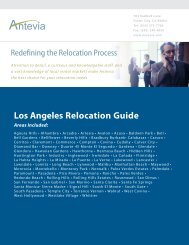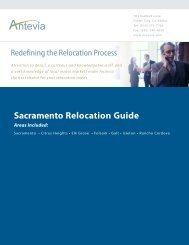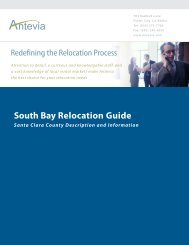San Francisco Relocation Guide - Antevia
San Francisco Relocation Guide - Antevia
San Francisco Relocation Guide - Antevia
You also want an ePaper? Increase the reach of your titles
YUMPU automatically turns print PDFs into web optimized ePapers that Google loves.
Major features<br />
Japanese Tea Garden<br />
A step-stone bridge in the Japanese Tea Garden<br />
The Japanese tea garden, an immensely popular feature, was originally built as part of a<br />
sprawling World's Fair, the 1894 California Midwinter International Exposition[1].<br />
Notable as the oldest public Japanese garden in the U.S., this intricate complex of<br />
many paths, ponds and a teahouse features native Japanese and Chinese plants. Also<br />
hidden throughout its five acres (20,000 m²) are beautiful sculptures and bridges. Makato<br />
Hagiwara, a Japanese gardener who was official caretaker of the garden from 1895 to<br />
1942, was also the inventor of the fortune cookie. A persistent (but likely apocryphal)<br />
legend records that the Japanese ambassador, after being shown its features and asked his<br />
opinion, gasped, "We have nothing to equal it in Japan."<br />
The Music Concourse Area<br />
The Music Concourse is an open area with three water fountains surrounded with maple<br />
trees positioned uniformally. There is also a stage on the east side. The buildings near the<br />
conourse area include The Academy of Sciences and the De Young Museum.<br />
In 2003 Music Concourse is also undergoing a series improvements to include an<br />
underground 800-car parking garage, narrowing of the roadways in the Music Concourse,<br />
the addition of bike lanes, and the elimination of existing surface parking.







